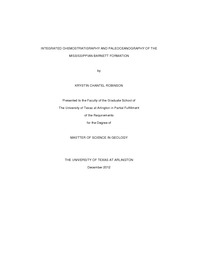
ATTENTION: The works hosted here are being migrated to a new repository that will consolidate resources, improve discoverability, and better show UTA's research impact on the global community. We will update authors as the migration progresses. Please see MavMatrix for more information.
Show simple item record
| dc.contributor.author | Robinson, Krystin Chantel | en_US |
| dc.date.accessioned | 2013-03-20T19:11:51Z | |
| dc.date.available | 2013-03-20T19:11:51Z | |
| dc.date.issued | 2013-03-20 | |
| dc.date.submitted | January 2012 | en_US |
| dc.identifier.other | DISS-11962 | en_US |
| dc.identifier.uri | http://hdl.handle.net/10106/11565 | |
| dc.description.abstract | The Barnett Formation was deposited on a gently sloping marine margin that ultimately became the Fort Worth Basin (FWB), a foreland basin that evolved during the late Paleozoic Era. The FWB formed as a result of the early Ouachita Orogeny, due to the collision of Laurasia and Gondwana. The Mississippian Barnett Formation is an organic-rich lithologic unit composed primarily of laminated siliceous mudrock with some calcareous mudrock intervals. The objective of the project is to develop and interpret stratigraphic changes in the geochemistry of the Barnett Formation for the purposes of understanding the paleoceanography of the northernmost Fort Worth Basin, and refining the stratigraphy for the oil and gas industry. Methods used to carry out the project include: real-time geochemical analysis using x-ray fluorescence (XRF) of the core face, TOC (total organic carbon) and TIC (total inorganic carbon) analysis, and stable carbon isotope analysis of organic and inorganic constituents. The elevated occurrence of redox-sensitive trace elements, including molybdenum, vanadium, zinc and uranium, suggests that periods of anoxia and euxinia (free sulfide) existed during deposition. These conditions likely contributed to a high level of organic preservation. Major elemental components (%Si, %Al, and %Ca) indicate the dominance of quartz, clay, and calcite, respectively, with the latter dominating the underlying strata (Late Ordovician Viola Formation) and the overlying strata (Upper Mississippian Forestburg Formation). Thin carbonate-rich layers within the Barnett may reflect calcite-rich density flows derived from a nearby carbonate platform (Chappel Limestone). These results add to the general knowledge of the stratigraphy of the Barnett Formation, and provide further support for interpreting well log data and deriving more comprehensive models of depositional environments. | en_US |
| dc.description.sponsorship | Rowe, Harold | en_US |
| dc.language.iso | en | en_US |
| dc.publisher | Geology | en_US |
| dc.title | Integrated Chemostratigraphy And Paleoceanography Of The Mississippian Barnett Formation | en_US |
| dc.type | M.S. | en_US |
| dc.contributor.committeeChair | Rowe, Harold | en_US |
| dc.degree.department | Geology | en_US |
| dc.degree.discipline | Geology | en_US |
| dc.degree.grantor | University of Texas at Arlington | en_US |
| dc.degree.level | masters | en_US |
| dc.degree.name | M.S. | en_US |
Files in this item
- Name:
- Robinson_uta_2502M_11962.pdf
- Size:
- 3.549Mb
- Format:
- PDF
This item appears in the following Collection(s)
Show simple item record


